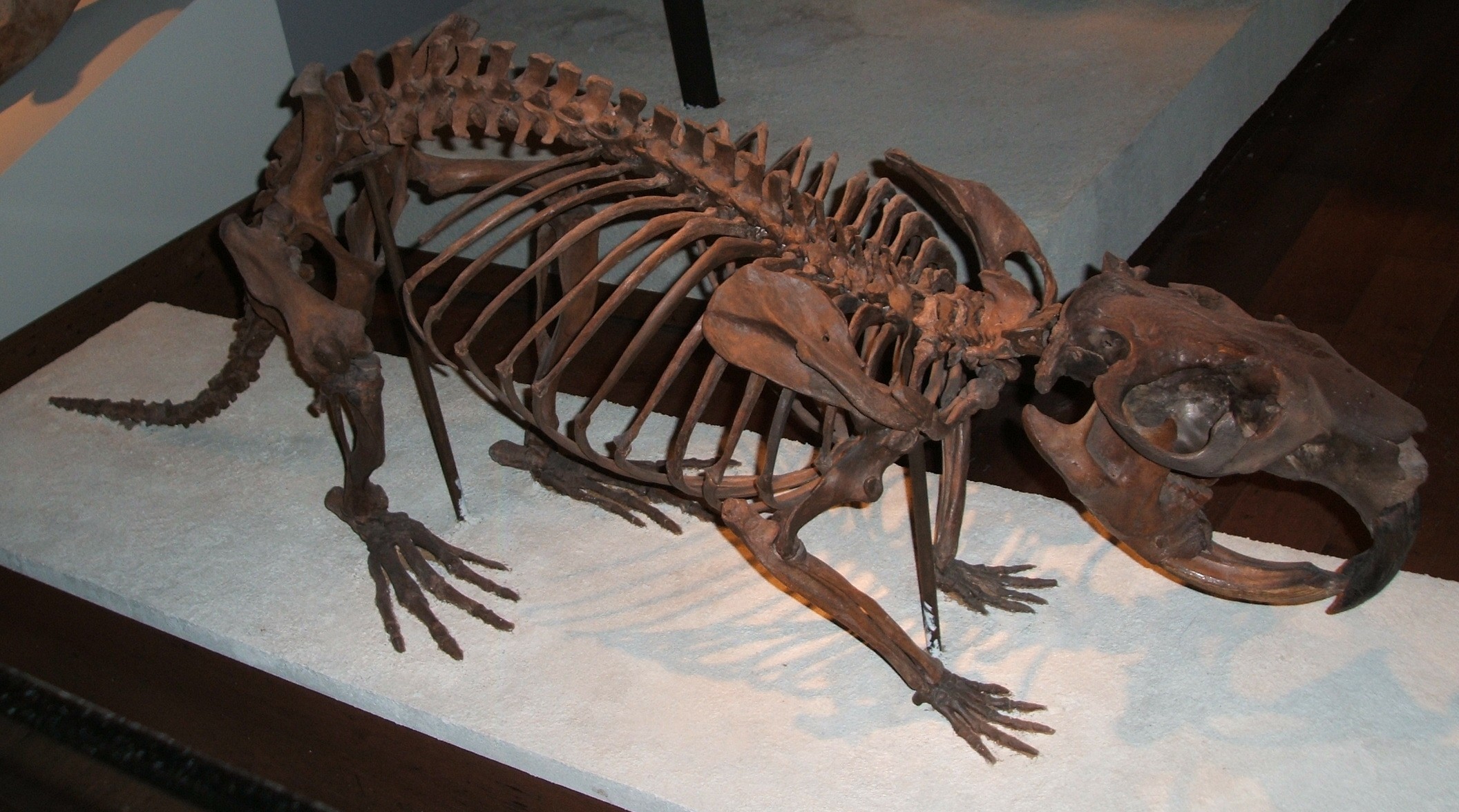- Giant Beaver
Taxobox
name = Giant Beaver
fossil_range =Pleistocene

image_width = 250px
image_caption = "Castoroides ohioensis",Field Museum
regnum =Animal ia
phylum =Chordata
classis =Mammal ia
ordo =Rodent ia
familia =Castoridae
genus = †"Castoroides "
species = †"C. ohioensis"
species_authority = Foster, 1838
binomial = †"Castoroides ohioensis"
synonyms = †"Castoroides nebrascensis" Barbour, 1931
†"Burosor efforsorius" Starrett, 1956The Giant Beaver ("Castoroides ohioensis") was a huge species of rodent, with a length up to 2.5 m (8.2 ft)cite book | author = Kurtén, B. and E. Anderson | title = Pleistocene Mammals of North America | publisher =
Columbia University Press | year = 1980 | pages = pp.236-237 | id = ISBN 0231037333] and an estimated weight of 60-100 kg (130-220 lbs); past estimates went up to 220 kg (485 lbs).cite journal | author = Reynolds, P.S. | year = 2002 | title = How big is a giant? The importance of methods in estimating body size of extinct mammals | journal = Journal of Mammalogy | volume = 83 | issue = 2 | pages = 321–332 | doi = 10.1644/1545-1542(2002)083<0321:HBIAGT>2.0.CO;2] It lived in North America during thePleistocene epoch, and went extinct at the end of the lastIce Age , 10,000 years ago.cite web | last = Harrington | first = C.R. | title = Yukon Beringia Interpretive Center - Giant Beaver | date = 1996 | url = http://www.beringia.com/02/02maina6.html | accessdate = 2007-09-17 ] The extinction of the Giant Beaver may have been due to ecological restructuring at the end of the Pleistocene.cite journal | author = Parmalee, P.W. and R.W. Graham | year = 2002 | title = Additional records of the Giant Beaver, Castoroides, from the mid-South: Alabama, Tennessee, and South Carolina | journal = Smithsonian Contributions to Paleobiology | volume = 93 | issue = | pages = 65–71 | url = http://www.sil.si.edu/smithsoniancontributions/Paleobiology/pdf_hi/SCtP-0093.pdf] The arrival of humans in the Americas could have been a factor, but there is no evidence that humans hunted the Giant Beaver. It was one of the abundantPleistocene megafauna — a wide variety of very large mammals that lived during the Pleistocene.Fossils of the Giant Beaver are concentrated around the Midwestern United States in states near the
Great Lakes , particularlyIllinois andIndiana , but specimens are recorded fromAlaska andCanada toFlorida . Specimens from Florida have been placed in asubspecies , "Castoroides ohioensis dilophidus", based on differences inpremolar and molar features.cite journal | author = Martin, R.A. | year = 1969 | title = Taxonomy of the giant Pleistocene beaver "Castoroides" from Florida | journal = Journal of Paleontology | volume = 43 | issue = 4 | pages = 1033–1041]One of the important anatomical differences between the Giant Beaver and modern
beaver species, besides size, is the structure of their teeth. Modern beavers have chisel-likeincisor teeth for gnawing on wood. The teeth of the Giant Beaver are bigger and broader, and grew to about 15 centimeters (6 inches) long. In addition, the tail of the Giant Beaver must have been longer but narrower, and its hind legs shorter. Its great bulk might have restricted its movement on land (although large squat-leggedhippopotamus es can move on land with little difficulty).The first Giant Beaver fossils were discovered in 1837 in a peat bog in
Ohio , hence its species epithet "ohioensis". Nothing is known on whether or not the Giant Beaver built lodges like modern beavers. In Ohio, there have been claims of a possible Giant Beaver lodge four feet high and eight feet in diameter, formed from small saplings. The recent discovery of clear evidence for lodge building in the related genus "Dipoides " indicates that the Giant Beaver probably also built lodges.cite journal | author = Rybczynski, N. | year = 2007 | title = Castorid phylogenetics: implications for the evolution of swimming and tree-exploitation in beavers | journal = Journal of Mammalian Evolution | volume = 14 | issue = 1 | pages = 1–35 | doi = 10.1007/s10914-006-9017-3]Folklore
Both the native
Mi'kmaq people of Canada and the nativePocumtuck people of theConnecticut River Valley ofMassachusetts have related significant myths about giant beavers; seeGlooscap andPocumtuck Range for details.References
External links
* [http://www.nature.ca/notebooks/english/giantbev.htm Canadian Museum of Nature: Giant beaver]
* [http://www.beringia.com/02/02maina6.html Beringia: Giant beaver]
* [http://my.execpc.com/~coken2/exhibita.jpgPicture of a giant beaver]
* [http://www.cycadpro.com/Images/Gallery/Ancient%20Mammals/AncientMammal4.jpgPic 2]
* [http://mapserver.museum.state.il.us/faunmapweb/faunmap.phtml?Age=ALL&Form=scientific&Taxon=CIoh&dist=y FaunMap query for "Castoroides ohioensis"]
Wikimedia Foundation. 2010.
